Stanley Sport Aviation Association — An Encouraging Lesson on How to Get it Right
By Jack Neima, EAA Canadian Council, EAA 413636
March 2020 - Despite decades of relentless challenges and obstacles that have been universally experienced in general aviation, a beacon of success continues to burn brightly in rural Nova Scotia. Stanley (CCW4), a little flying-club-operated grassroots airport, is proof that dedication, determination, and a strong vision are the key ingredients to long-term growth and success. Their official name is Stanley Sport Aviation Association, but they are well known, especially throughout eastern Canada, simply as "Stanley." Their leaders and some of the most active long-term members have agreed to share with readers of Bits and Pieces some valuable lessons that have been learned over the years. More on that later, but first some background.
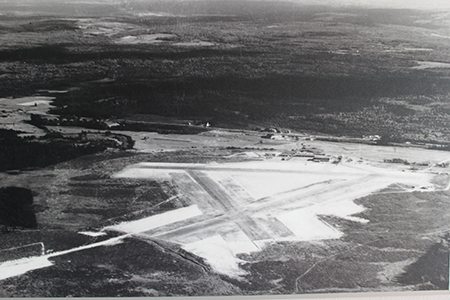
BCAPT base at Stanley under construction, circa 1941. Photo courtesy of Don Ledger.
Originally formed in 1966 as "Dartmouth Experimental Aircraft Association EAA Chapter 305," this flying club has enjoyed an unbroken history of progress and growth. In 1968, they were able to lease from the Province of Nova Scotia the former BCATP Elementary Flying Training base at Stanley, about 45 kilometres north of Halifax.
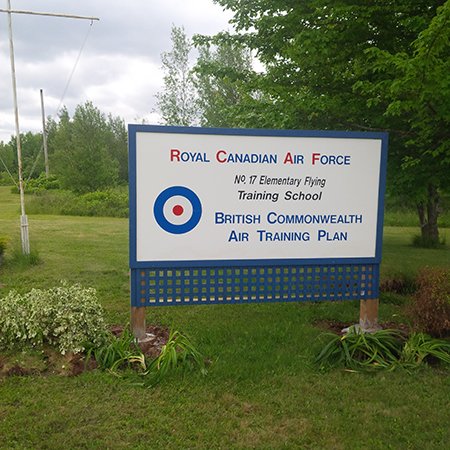
BCATP sign. Photo courtesy of Jack Neima.
Work began immediately to reclaim the runways and 640 acres of remaining airport infrastructure that had been left to decay over the past 20+ years. This was hard physical work but, thankfully, there were enough capable hands to reverse the decline, and slowly an airport began to re-emerge. Once the runways became serviceable, private aircraft started to congregate and the club was able to make use of the large World War II era hangar that was still functional, although the space was shared with elements of the Provincial Department of Lands and Forests.
The flying club now had a home base and a growing membership who were eager to work towards the clear vision to provide a place where recreational aviators could gather with like-minded folks, to lend their skills and talents with the objective of keeping costs at a minimum, thereby making aviation accessible to the broadest base of enthusiasts. That objective sounds familiar, as it also figured prominently in EAA's founding principles.
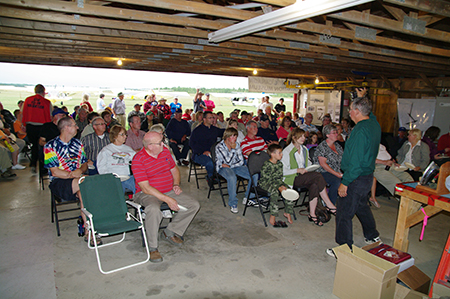
Fundraising auction at the annual Stanley Labour Day Fly-In. Photo courtesy of Don Ledger.
As the years unfolded, Stanley's cost-minimizing culture took shape, made possible by continuously tapping into the deepening pool of free labour. Fueling facilities and a well-equipped clubhouse were added, as were several club-owned hangars, tools, and equipment sheds. The hangars added a permanent source of ongoing revenue, which in turn enabled the club to expand member services and finance the growing maintenance requirements. Many of the members were spending lots of time at Stanley, and through their cooperative efforts a friendly atmosphere was evolving. This led to the establishment of water, sewerage, and electrical facilities, which allowed members to bring trailers and their families to spend summer weekends with like-minded friends. The family-oriented atmosphere was key, and many children grew up with deep roots in the Stanley aviation community.
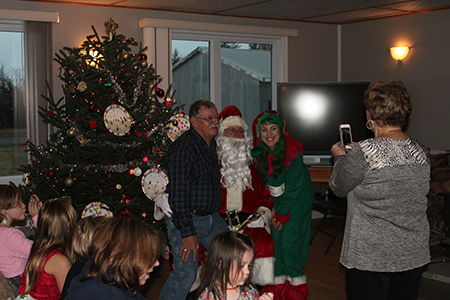
Santa arrives at a children's Christmas party at Stanley, seen here with club president Kevin Layden on his lap. Photo courtesy of Don Ledger.
In addition to the preservation of cost-effective flying, a new objective — having fun with family and friends — began to emerge to offset the ongoing hard work to build a fully functioning grassroots airport. The usual fly-outs, fly-ins, barbecues, pancake breakfasts, et cetera. became more and more frequent, leaving an imprint on the membership, which grew to 100 or more.
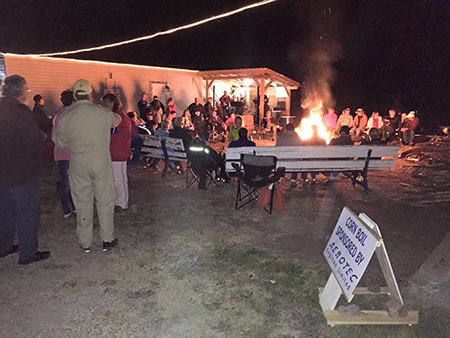
Campfire and party at Stanley Airport.
One of the biggest developments came in 1970 when it was decided to host a big fly-in over the Labour Day weekend, which was a great success, attracting aircraft from all over the Maritime Provinces. This fly-in became an annual affair and eventually a three-day event, with activities starting on the Friday of Labour Day weekend and often not wrapping up until early the following week.
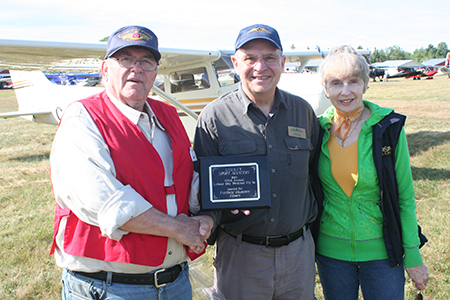
Presentation of the Furthest Distance Flown award. Photo courtesy of Don Ledger.
Flying demonstrations, spot-landing contests, forums, flea markets, auctions, and of course camping under wing added to the festivities and made the annual fly-in a well-known "must do" event that continues to this day. In its heyday in the 1980s and '90s, it even became necessary to occasionally close one of the runways to provide overflow parking.
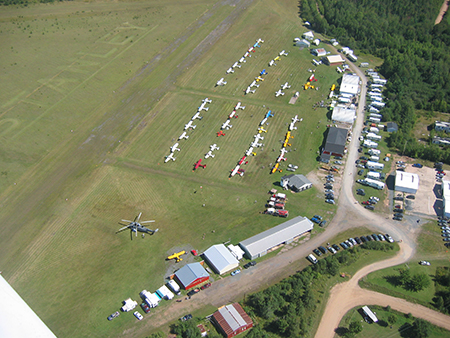
CCW4 viewed from above. Photo courtesy of Ron Cooper.
While some of the activities have reduced in scale from their late 20th century peaks, almost all of them continue, including an annual fly-in that remains very well attended. Flying economically and enjoying our pastime with like-minded friends is still the dominant culture around Stanley Airport, and many of the senior members remain actively engaged. The hard work continues, but more and more it has swung from building towards maintenance, which is allowing these senior members to mentor newcomers and to enjoy a well-earned rest.
Regrettably, Stanley's official association with EAA ended in the 1990s when it became impossible to continue offering fuel sales, hangar rents, and other revenue-generating activities without running afoul of EAA's chapter requirements. (Author's note: Other former EAA chapters experienced similar challenges and parted company around the same time, but the good news is that several of these have since discovered compromise solutions and have returned to the EAA family.)
What about those lessons? We talked to a number of Stanley's senior members who are in a great position to reflect on the club's history and share some insights about why they continue to thrive and grow while others struggle to survive.
Stanley Sport Aviation Association's current president, Kevin Layden, attributes the club's longevity and success to a few critically important factors, including:
- A lot of hard physical labour in the early years.
- A steady supply of skilled volunteer support by pilots AND their family members.
- The ability to get things done without having to hire services.
- Having fun — fly-ins, fly-outs, camping, lots of bonfires and hayrides!
- Maintaining a strict focus on the "not-for-profit" status with a singular objective of keeping costs down for pilots and aircraft owners.
Longtime member Don Ledger agrees. He adds they would not have made it work without a continuous and diverse array of fundraising. Don believes that many grassroots airports have become little more than a place to park aircraft between flights, but Stanley is different. The cooperative work, and especially the socializing that characterizes the Stanley community, has really set it apart and is the reason the club remains viable and vibrant to this day.
Despite the obvious past successes, both Kevin and Don spoke to us about the key challenges that are yet to be overcome. We share their concern about the need to attract new, hopefully younger, participants as members who will grow into leadership roles to carry us into the future. In fact, Don goes so far as to call it "a struggle that is shifting toward the prevention of our self-destruction." By this, he means that unless these flying clubs find a way to attract and retain members who can replenish the supply of skilled volunteer labour, it's unlikely they will be able to afford the cost of maintaining what is being passed on to us by the "pioneers."
Kevin has added a few comments about the future as well. In addition to a relentless focus on minimizing costs, he suggests that clubs need to stay ahead of maintenance and improvement projects, and that even if sometimes these appear to be a hard pill to swallow, if you get behind you may not be able to recover. He is a firm believer in the value of family-oriented activities, and he thinks that a prohibition on commercial activity is absolutely necessary.
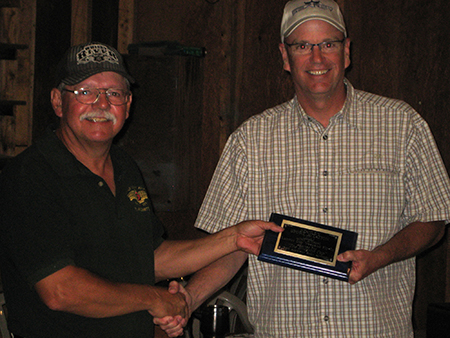
Stanley president Kevin Layden presents the Best Amateur Built award to Tom Sabean. Photo courtesy of Don Ledger.
We appreciate the willingness of Stanley's leaders to share their success story with us and their forward-thinking recommendations. We believe the challenges, and hopefully some of the successes, illustrated in the story of the Stanley Sport Aviation Association would be mirrored by similar grassroots flying clubs across the country, and our collective attention and hard work will be necessary to reverse some of the declining trends. The good news is that EAA is well positioned to provide a wide range of help in overcoming these challenges, and we hope to share additional advice and success stories about other clubs and airports who are defying the odds to succeed in the face of adversity. If you have an inspiring story, we encourage you to share it through the pages of Bits and Pieces. We are always looking for good news and uplifting stories.
We close with one thought that relates directly to advice from Kevin and Don: the need to attract younger participants. This idea is behind our new EAA Canadian Pathways initiative, which aims to attract young adults to participate in construction and/or rebuild programs at EAA chapters. We hope this will in turn lead to the formation of new chapter-affiliated flying clubs that will provide economical access to recreational aviation for people who might not otherwise be able to participate. You can get more information on this initiative from your local EAA chapter president or by contacting the EAA Canadian Council.
For more information on the Stanley Sport Aviation Association, check out:
Website: stanleysportaviation.ns.ca/
Facebook: Stanley Sport Aviation
